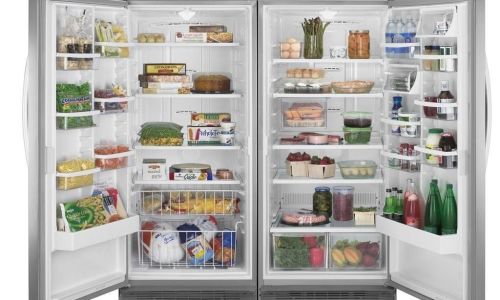Introduction
The question of whether a freezer can be repurposed into a refrigerator is a common inquiry among budget-conscious consumers, DIY enthusiasts, and those seeking sustainable solutions for appliance management. At first glance, both freezers and refrigerators serve the broad purpose of preserving food by maintaining cold temperatures. However, their designs, components, and operational mechanisms differ significantly. This article explores the technical feasibility, practical challenges, and potential risks of converting a freezer into a refrigerator, offering insights into whether such a project is worthwhile.
Understanding the Fundamental Differences
Freezers and refrigerators operate on the same thermodynamic principles but are engineered for distinct temperature ranges. A standard freezer maintains temperatures between 0°F (-18°C) and -10°F (-23°C), designed to keep food frozen indefinitely. In contrast, a refrigerator cycles between 35°F (2°C) and 40°F (4°C), a range that slows bacterial growth without freezing. The key components—compressors, thermostats, and insulation—are calibrated differently for these roles.

A freezer’s compressor is optimized for continuous operation at lower temperatures, while a refrigerator’s compressor cycles on and off more frequently to maintain a warmer environment. The thermostat in a freezer is calibrated to trigger the compressor only when temperatures rise above 0°F, whereas a refrigerator’s thermostat responds to higher thresholds. Additionally, freezers often have thicker insulation to minimize heat infiltration, which can affect energy efficiency when repurposed.
The Conversion Process: Technical Steps and Considerations
Converting a freezer into a refrigerator involves modifying its temperature control system. The primary challenge lies in adjusting the thermostat to maintain temperatures within the refrigerator range. Here’s a step-by-step breakdown of the process:
-
Thermostat Replacement or Adjustment:
- Most freezers have a fixed thermostat that cannot be manually adjusted beyond their factory settings. Replacing the thermostat with a refrigerator-grade model (typically rated for 35–40°F) is the most straightforward solution. Aftermarket thermostats with adjustable dials are available, but compatibility varies by brand and model.
- For freezers with manual dials, some users report success by rotating the dial to its warmest setting. However, this method is unreliable, as the internal mechanism may not physically allow temperatures above freezing.
-
External Temperature Control Systems:
- If replacing the thermostat is impractical, an external temperature controller can be installed. These devices, often used in homebrewing or fermentation, plug into an electrical outlet and regulate the freezer’s power based on an external probe. By setting the controller to 40°F, the freezer’s compressor will cycle on and off to maintain this temperature.
- This approach bypasses the original thermostat entirely but requires drilling a small hole for the probe and may void the appliance’s warranty.
-
Defrost Timer Modifications:
Freezers with automatic defrost cycles may need timer adjustments to prevent excessive icing at higher temperatures. Manual-defrost models are simpler to convert but require periodic monitoring to remove frost buildup.
-
Insulation and Airflow:
While freezers have robust insulation, their airflow patterns differ from refrigerators. Freezers prioritize even cold distribution to prevent freezer burn, while refrigerators use fans to circulate air and prevent temperature stratification. Installing a small fan inside the converted freezer can mimic refrigerator airflow, though this increases energy consumption.
Energy Efficiency and Cost Implications
One potential benefit of conversion is energy savings. Freezers are designed for continuous operation, but when repurposed as refrigerators, they may cycle less frequently, reducing electricity usage. However, this depends on the age and efficiency of the original unit. A 20-year-old freezer converted into a refrigerator could still consume more energy than a modern Energy Star-rated model.
A study by the U.S. Department of Energy suggests that refrigerators built before 1990 use twice as much energy as newer models. If the goal is long-term efficiency, investing in a dedicated refrigerator may be more cost-effective than modifying an outdated freezer.
Practical Challenges and Risks
Despite the technical feasibility, several practical hurdles exist:
-
Temperature Instability:
Freezers converted using external controllers may experience temperature fluctuations, especially in hot or humid environments. Inconsistent cooling can compromise food safety, as bacteria multiply rapidly between 40°F and 140°F (4°C–60°C).
-
Warranty and Safety Concerns:
Modifying a freezer’s electrical components voids most manufacturer warranties. Improper wiring or component mismatches could also pose fire hazards.
-
Space Utilization:

Freezers, particularly chest-style models, have limited shelf space compared to upright refrigerators. Converting a chest freezer into a refrigerator may require custom shelving, which reduces storage capacity.
-
Noise and Lifespan:
Running a freezer’s compressor at higher temperatures than intended could shorten its lifespan. The compressor may overheat or wear out faster due to increased cycling.
Alternative Solutions: When Conversion Isn’t Ideal
For those seeking a refrigerator without purchasing a new unit, several alternatives exist:
-
Used Refrigerators:
Secondhand appliances are often available at a fraction of the cost of new models. A well-maintained 10-year-old refrigerator may outperform a converted freezer in efficiency and reliability.
-
Mini Fridges:
Compact refrigerators are affordable and ideal for small spaces. While less energy-efficient than full-size models, they avoid the complexities of conversion.
-
Repurposing Without Modification:
Some users employ freezers as refrigerators without modifications, relying on ambient room temperature to limit cooling. This method is highly unreliable and risks food spoilage.
Case Studies and Real-World Examples
Several online communities and DIY forums document successful freezer-to-refrigerator conversions. For instance, homebrewers often convert chest freezers into kegerators or fermentation chambers using external controllers. These projects highlight the viability of the conversion for specialized uses but emphasize the need for precise temperature management.
Conversely, a 2021 survey by Appliance Repair Specialists found that 35% of converted freezers experienced mechanical failures within two years, primarily due to compressor strain. This underscores the importance of careful component selection and monitoring.
Environmental and Ethical Considerations
Repurposing an old freezer extends its lifespan, reducing electronic waste. However, if the conversion leads to higher energy consumption, the environmental benefit diminishes. Recycling an inefficient freezer and purchasing an Energy Star refrigerator may be the greener choice in the long run.
Conclusion: Weighing the Pros and Cons
Converting a freezer into a refrigerator is technically feasible but requires careful planning and execution. The success of the project hinges on the freezer’s age, model, and the user’s technical expertise. While it offers a low-cost solution for specific applications—such as beverage storage or fermentation—it may not suit general household use.
For those willing to invest time in research and modification, the conversion can provide a functional refrigerator. However, most consumers will find greater reliability, efficiency, and safety in purchasing a dedicated refrigerator, whether new or used. As with any DIY appliance project, balancing cost savings with practicality and safety remains paramount.





0 comments